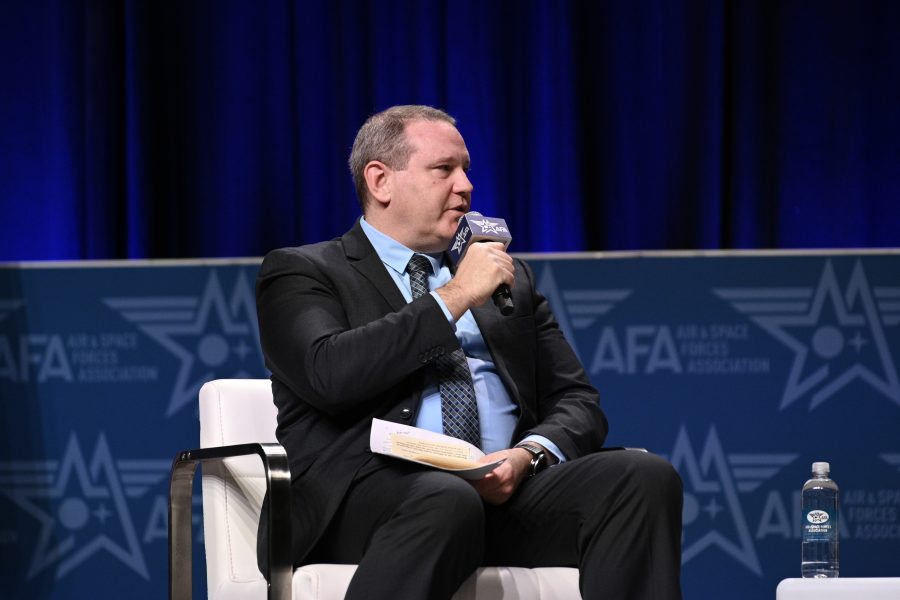Spending caps set under the Fiscal Responsibility Act shaved around two percent from the topline of the Air Force’s planned fiscal 2025 budget, and that reduction will have an outsized impact given constraints on what accounts can bear the cuts, Air Force acquisition executive Andrew Hunter said March 7.
Speaking to reporters at the annual McAleese defense conference in Washington, D.C., Hunter said the Air Force’s budget will take a cut “on the order of a couple of percent” from its previously anticipated topline due to the FRA. The law, passed last summer, came into force when the services had already largely figured out their budget submissions for fiscal 2025, he noted.
Although two percent “sounds small … there’s only a handful of places” from which the funding can be reduced, Hunter said. Personnel accounts are largely protected, so “your readiness accounts and modernization accounts” were hit disproportionately. Those accounts were the “easiest to get to” given the short time available to adapt to the FRA, he said.
Hunter was unable to offer more details, because the budget will not be unveiled until March 11. He did, however, offer a rundown on some of the Air Force’s highest-profile programs and discussed the issue of lowball bids from industry and fixed-price contracts.
Collaborative Combat Aircraft
The Air Force recently selected five companies to complete on the first increment of the Collaborative Combat Aircraft program, which will produce autonomous drones to team with manned platforms. Those companies, Hunter said, all had to do substantive work on autonomous vehicles to be picked. He noted that General Atomics had done work on the OBSS (Off-Board Sensing Station) platform which brought “maturity” to its CCA efforts, and Anduril acquired Blue Force Technologies, which had the pre-existing Fury program.
The others—Boeing, Lockheed Martin and Northrop Grumman—“had things they developed under IRAD,” or independent research and development, he added. “Quite honestly, if they didn’t have that … they weren’t really in a position to compete for Increment 1,” Hunter said.
Aerial Tankers
The Air Force wants to get the Next-Generation Air-Refueling System (NGAS) “in the quickest, most reasonable timeframe,” Hunter said, because in a Pacific campaign, tankers deployed near and inside contested areas will be crucial. That’s “not something we typically do today.”
In the meantime, the service is working on a KC-135 Re-Capitalization program, previously called the “bridge tanker.” Boeing and Airbus have both responded to requests for information for the program, which will keep tankers in production while the NGAS is in development, Hunter said.
That program will begin production “in five-ish years” and USAF is starting now because it needs a “pretty mature” solution at that point to avoid a break in manufacturing, he said. “And we have been talking to industry about how do we cut down on that period.”
Both companies provided responses, and now the Air Force is working with them to “clarify what those offerings look like and to evaluate them against our need dates and our requirements,” Hunter said.
The scope of requirements for the KC-135 Re-Capitalization program has been reduced, Hunter said, and a milestone is coming soon.
“We’re looking this summer to make a final decision, based on the information we received from industry, on our acquisition strategy,” he said.
E-7A Wedgetail
After Air Force Secretary Frank Kendall revealed last month that the service and Boeing are having a “hard time” reaching a price agreement on the first two rapid prototype/demonstration examples of the E-7 Wedgetail, Hunter offered more details.
Boeing’s proposal for the E-7, which will succeed the E-3 Sentry as the service’s airborne battle management platform, was “well in excess of what we budgeted and unaffordable.”
Negotiations thus far have “significantly narrowed the gap. We’re not there yet, but we’ve made a lot of progress,” Hunter said. He added that he sees the E-7 as “a capability that makes sense and that we need to field in the near term. So we are working very, very hard with Boeing to get to get to an affordable price” and move on into production.
Lowball Bids
The Air Force wants a healthy industrial base, Hunter said, and it is discouraging companies from offering lowball bids on programs, which have gotten some—notably Boeing, which is more than $7 billion in the red on the KC-46—in serious financial trouble.
“We sometimes say, ‘Hey, you’re not in the competitive range, right? Your price is amazing, but we don’t believe it,’” Hunter said. “So you can exclude people from the competitive range because … they just can’t actually do what they say they’re going to do.”
But sometimes the Air Force’s hands are tied when the service knows a company “can probably do it, but you’re going to lose a ton of money at the price you bid,” Hunter said.
Such concerns aren’t part of the evaluation process, Hunter said. Instead, the Air Force has addressed by the problem by becoming “very cautious about when we make cost the primary criteria,” he said. “I would say [in] most of our big competitions these days, price is not the preeminent factor in our evaluation.”
Divestiture of Older Aircraft
Hunter said there will have to be significant adjustment of the fiscal 2025 budget if Congress doesn’t approve the fiscal 2024 budget as it stands, particularly as it affects the divestiture of older aircraft. The Air Force needs the personnel associated with those aircraft for new programs, particularly the F-35, he said. Retaining older aircraft requires operation and maintenance funds, personnel, and “safety of flight” modifications the Air Force hadn’t planned for, he said, and it disrupts and delays introducing new systems.
